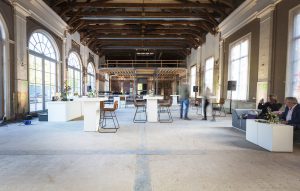Museum Artis

| Categorie | Publieke projecten |
|---|---|
| Jaar | 2020 |
| Land | Benelux |
| Organisatie | Vic Obdam |
| Auteur | Thijmen Blankendaal |
| Co-auteurs | Dilu Beenker |
| Cliënt | B.C. Nico de Bont & Mobilis vof - Vught |
| Plaats van constructie | Amsterdam |
| Tags |
De restauratie van het eerste en oudste museum van Amsterdam is in 2017 officieel van start gegaan. Vic Obdam heeft hiervoor de staalconstructie geproduceerd en geleverd. Het was een logistieke uitdaging om al het staal op zijn plek te krijgen in het monumentale gebouw. De restauratie vormt het sluitstuk van de vernieuwingen die ARTIS in 2003 is begonnen.
De inpandige constructie van maar liefst 76 ton heeft ervoor gezorgd dat het nieuwe museum weer volledig beschikbaar is voor de hedendaagse bezoekersaantallen. Met de nieuw liftschachten is het museum ook te bezoeken voor mindervalide mensen.
Grotendeels van de bestaand verdiepingsvloeren zijn behouden gebleven. Dit is gelijk de grote uitdaging geweest van het project. Hoe monteer je inpandig zwaar vakwerkspanten van 2,5 ton per stuk waarbij de beschikbare vloerbelasting in de bouwfase beperkt is tot 500kg/m2. Een combinatie tussen een takel constructie op de eerste verdieping in combinatie met een tijdelijke dubbele kunststofdekvloer bood de oplossing. De nieuwe staalconstructie werk samen met de bestaand houten vakwerkspanten en vloerdelen. De oude en nieuwe constructie maakt het monumentale museum klaar voor de toekomst.
Middels een takelconstructie op de eerste verdiepingsvloer is de begane grondvloer ontlast van een zware inpandige kraan. Daarnaast heeft het uitschuifbaar rolsysteem ervoor gezorgd dat de bestaand kroonlijst behouden is gebleven. De enige belasting die het kritische deel van de begane grondvloer uiteindelijk heeft moeten dragen tijdens de bouw is gekomen van hoogwerkers en de aanvoer van de staalconstructie.
Naast de beperkte belasting van de begane grondvloer bracht het behoudt van de houten vakwerkspanten een andere uitdaging met zich mee. De houten vakwerkspanten staan dicht op elkaar waardoor er het plaatsen van een ondersteuningsbalk onder de boven ligger van het houten vakwerk van onder of boven niet mogelijk bleek. Uiteindelijk is de oplossing gevonden in het middendeel van het museum. Op de hoogte waar de stalenliggers moesten komen is een sparing gemaakt in de tussenmuur en middels een hangconstructie met rollen zijn de liggers over een lengte van 21 meter door de vakwerken gemaneuvreerd.
The restoration of the first and oldest museum in Amsterdam has officially started in 2017. Vic Obdam produced and supplied the steel structure for this. It was a logistical challenge to get all the steel in place in the monumental building. The restoration is the culmination of the renovations that ARTIS started in 2003.
The indoor construction of no less than 76 tons has ensured that the new museum is once again fully available for contemporary visitor numbers. With the new lift shafts, the museum can also be visited by disabled people.
Most of the existing floors have been preserved. This has been the great challenge of the project. How to assemble indoor heavy trusses of 2.5 tons each where the available floor load in the construction phase is limited to 500kg/m2. A combination of a hoist construction on the first floor in combination with a temporary double plastic deck floor offered the solution. The new steel construction works together with the existing wooden trusses and floorboards. The old and new construction makes the monumental museum ready for the future.
By means of a hoist construction on the first floor, the ground floor is relieved of a heavy indoor crane. In addition, the retractable roller system ensures that the existing cornice is preserved. The only load that the critical part of the ground floor eventually had to bear during construction came from aerial work platforms and the supply of the steel construction.
In addition to the limited load on the ground floor, retaining the wooden trusses presented another challenge. The wooden trusses are placed close to each other so that it was not possible to place a support beam under the top beam of the wooden truss from below or above. Eventually, the solution was found in the middle section of the museum. At the height where the steel beams had to be, a recess was made in the intermediate wall and by means of a suspension construction with rollers, the beams were maneuvered through the trusses over a length of 21 metres.








